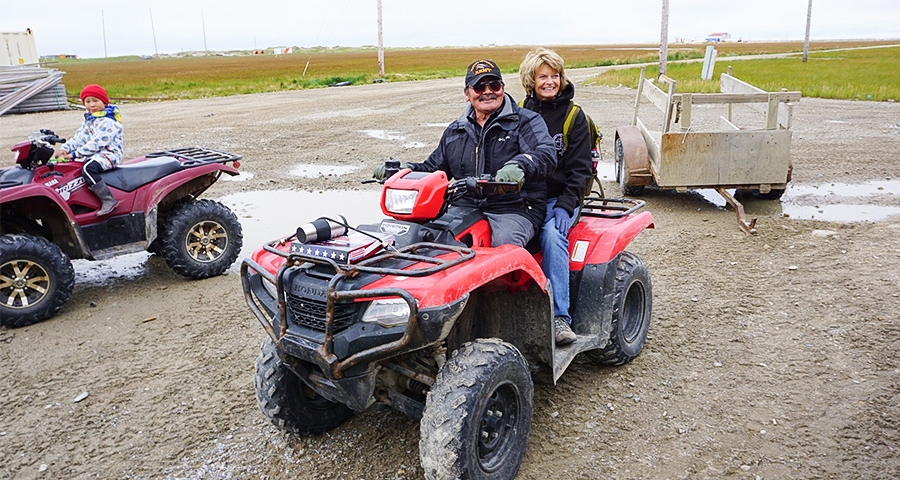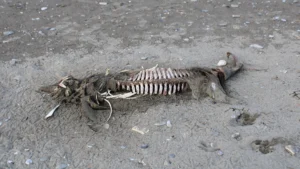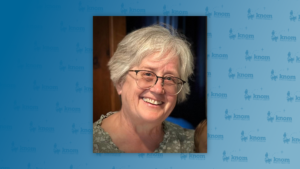In the first installment of a two-part series discussing unserviced communities in the Bering Strait region, we learned that five Alaska Native villages have spent decades fighting for basic sanitation. Now in Part 2, KNOM turns to how these communities are living through the coronavirus pandemic.
The Centers for Disease Control has recommended every person across the country wash their hands regularly throughout the day to prevent the spread of germs. Many in rural Alaska, without running water, are left asking: how?
“Hey that’s easier said than done. You guys can do it because your water runs right into your [home]. You guys get to shower. Up here we have to make do with what we have.”
– Frank Oxereok Jr.
Frank Oxereok Jr. is the mayor of Wales, a small coastal community with a population just south of 200. Wales relies on nearby streams for drinking water and uses honey-buckets to dispose of their sewage in a local lagoon.
According to Oxereok Jr., construction on a new washeteria is scheduled for July.
“Working with the State of Alaska takes a long time. What with the virus going around worldwide, hopefully it won’t slow down the construction of our new facility…. We’ve come a long ways.”
Meanwhile, in response to the Covid-19 pandemic, the Mayor of Wales has imposed quarantine rules and other guidelines on local residents.
“We have people that travel for medical [reasons]. We’re directing them—at first, we asked them—but now I think everybody understands they have to self-quarantine up to two weeks once they come back (to Wales).”
The lack of basic sanitation facilities in rural communities such as Wales has long been a subject of worry for public health watchdogs and government officials. In a Senate Indian Affairs Committee hearing this past December, Alaska Senator Lisa Murkowski detailed this concern:
“We have no running water. We have no sewer facilities. When you are not able to have clean water to drink or bathe in, disease is allowed to accumulate. We have issues—whether they are respiratory issues, whether they are communicable diseases that are shared.”
– Senator Lisa Murkowski

However, while Wales faces unique challenges amidst the pandemic, Oxereok Jr. thinks his community is uniquely prepared.
“There’s been concerns about that (the coronavirus) but not as many as I expected. We’re so used to just hauling our water in and hauling the gray water out. That’s just part of our lives.”
– Frank Oxereok Jr.
The Mayor’s sentiment is echoed throughout the region.
Alice Fitka, President of the Native Village of St. Michael, opened up her kitchen to KNOM in February. Two months later, she is still waiting for her water to be restored. As she picked up the phone earlier this month, Fitka coughed violently saying she is recovering from Bronchitis. With respect to the coronavirus, Fitka is adamant her community will find a way to follow CDC guidelines.
Fitka: “People are doing the best they can. They’re trying to be in compliance in what’s required about daily washing your hands. When people have to do what they have to do, they do it.”
KNOM: “Because when it’s life or death, you have to do it?”
Fitka: “Yeah, people will do what they have to do to survive. They know that in order to be healthy, they have to be in compliance and washing their hands daily.”
City officials in St. Michael have imposed a curfew and limited the number of individuals allowed in local businesses at one time to ten in the local store and five in the post office. Still, as long as the community’s system remains inoperative, those without vehicles must haul water on a sled in a daily ritual. Those in quarantine must rely on family and friends to haul water for them. The city mayor, Harold Hawkins, hopes the system will be fixed by the end of the April. He explains how the coronavirus has slowed repairs in St. Michael.
“One of our operators is on quarantine and he won’t be getting off until this week sometime. That put a bind on getting a crew out there to do the job. We only have one person and it needs two foremen out there to make sure things are going around the clock.”
– Harold Hawkins
Other public health officials have been affected as well, causing a slew of problems for the city.
“Well, both our sanitation workers happen to be quarantined, which is a very serious issue medically speaking—making sure we get that human waste up to the lagoon where it’s supposed to be instead of in the bins or on the side of the bins. We had to get someone to fill in the slot, until the other personnel is off quarantine.”

Photo: JoJo Phillips, KNOM.
Trained staff are already in short supply in communities like St. Michael. Furthermore, the effects of the pandemic impact are not limited to the physical and financial. It has weighed heavily on Hawkins’ mind.
“It puts a bind on us mentally… you know, people are in their homes. They want to get out and make a living, pay bills.”
While “Stay-at-Home Orders” are being protested elsewhere in the country, rural Alaskans are mostly complying and taking the threat of Covid-19 seriously. Mayor Oxereok of Wales, who is generally a picture of congeniality, turns somber when he talks about the virus. He and the majority of Wales remember the last pandemic to reach the village.
“Lesson learned. Back in 1918—you probably heard about that Spanish Flu, everybody knows about that I think. Shishmaref saved themselves. What they did is post armed guards on the dog-team trail and allowed nobody to enter. But here in Wales it was… we were devastated.”
– Frank Oxereok Jr.
Oxereok Jr. is referring to the Spanish Influenza, which came to Alaska in the fall of 1918. According to historian Alfred W. Crosby, who wrote extensively about the subject in America’s Forgotten Pandemic, the Spanish Flu killed up to 3,000 Alaskans, including eight percent of the Alaska Native population. In many communities, Wales included, the death toll was far worse.
“We never recovered to this day.”
Based on Crosby’s figures, it’s estimated that over half of the population of Wales perished in the early months of 1919. What was once one of the largest villages in the region became a ghost town and, a century gone by, empty houses still dot the rugged landscape today.
“My dad and two older brothers… they lost their parents during that time—1918—epidemic flu.”
– Raymond Seetok
Raymond Seetok was born in 1946. Now an elder, he has lived in Wales all his life. Seetok’s father and uncles were among approximately 40 children orphaned by the 1918 pandemic in Wales, as recorded by a local schoolteacher at the time. The traumatic impact of the Spanish Flu on Alaska Native villages is difficult to articulate; it exists on a generational scale, as Seetok explains.
“A lot of people died. There’s a big white cross at the cemetery. The buried over 600 people there. Along the beach. They buried people in the sand. It’s a big white cross. No markings on it. They covered the people they buried with canvas. That’s what I remember. That’s what my father used to tell us when we were growing up.”
Like Seetok, Mayor Oxereok Jr. grew up hearing stories of the 1918 Flu. While only one case of Covid-19 has been confirmed in the Bering Strait region as of this report, local entities and medical officials have been working hard to get ahead of the curve.
Even before the coronavirus appeared in the 49th state, Norton Sound Health Corporation officials scrambled to find cleaning supplies for the region’s unserviced communities. As anyone who has surfed Amazon recently knows, supplies of hand sanitizer and Clorox wipes are few and far between.
In an email, NSHC’s Self Governance Liaison Megan Alvanna-Stimpfle stated that NSHC was “able to secure a small amount of hand sanitizer from a pharmacy in Soldotna. They had to produce it for us, so it’s taken some time for production and delivery.”
As of the beginning of April, the unserviced communities of Wales, Stebbins, Teller, Diomede and Shishmaref were receiving at least one 8-oz bottle of hand sanitizer per home. Alvanna-Stimpfle went on to say that ANTHC has lobbied the state for more supplies.
Meanwhile, at the local level, even more creative options are being considered. According to Mayor Oxereok Jr., Wales is experimenting with making its own hand sanitizer.
“I heard about them using rubbing alcohol and mixing it with certain kinds of lotions. If they just use straight alcohol it would dry out their hands. I guess it’s gotta be certain kinds of lotions that will not react to the rubbing alcohol. I know there’s some rubbing alcohol in the Native store.”
– Frank Oxereok Jr.
Frank’s younger sister Anna, who is President of Wales’ Tribal Council, told KNOM the village has requested bottles of Aloe Vera from Nome. She recognizes that a strict recipe must be followed if the DIY sanitizer is to be effective. In her words, “in the villages you got to be a MacGyver at all times.”
As summer ends and the tundra reddens, Wales invites its neighbors to participate to an annual celebration: the Kingikmiut Dance Festival. At last year’s celebration, the King Island Dance Group performed the Wolf Dance. The Anchorage Kingikmiut Dancers performed a song about two holy men meeting on the ice between Wales and Diomede.

Anna Oxereok has already begun to think about this year’s event.
“Hopefully things will all be good so we can start preparing for our dance festival. We’ll need to have a big celebration once this thing [ends].”
– Anna Oxereok
If the Kingikmiut Festival isn’t canceled this year, visitors in the fall could see an unfamiliar structure gracing Wales’ shores. Construction on the new washeteria is slated to begin in July, pending further delays on account of the coronavirus.
Back in the early 1970s, Mayor Frank Oxereok was on the crew that built the old facility. Half-a-century later, his brick-laying days are over. The mayor doesn’t mind. There are ribbon-cutting days ahead.
Image at top: Mayor of Wales Frank Oxereok and Senator Lisa Murkowski on 4-wheelers as they tour the community. Photo from Geoff Koss, E&E News, used with permission (2019).





